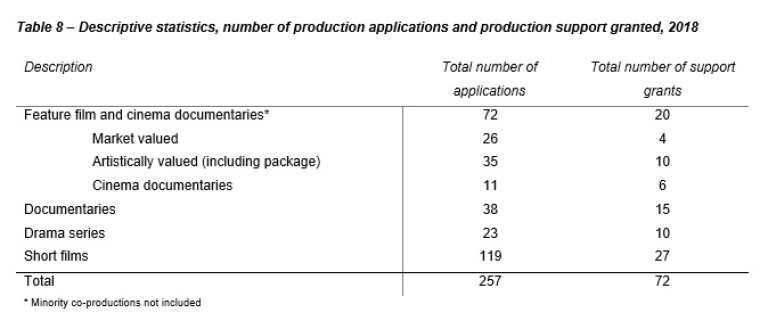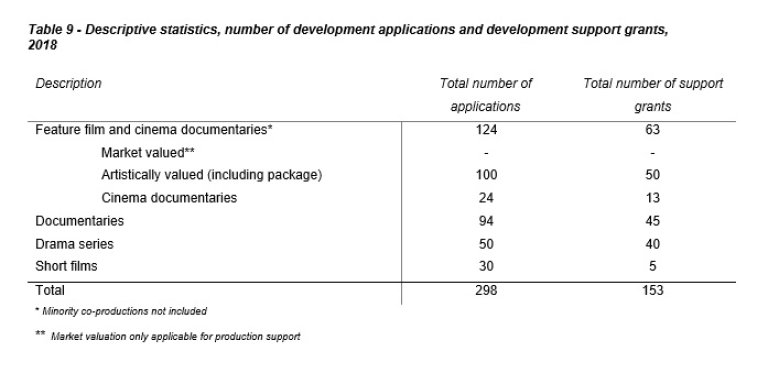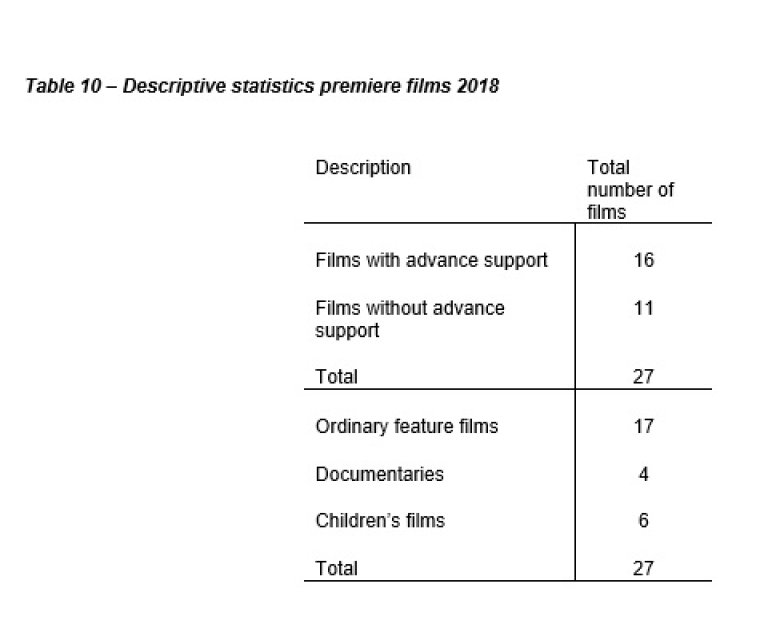The percentage of women in Norwegian film in 2018
- This gives us a boost of optimism to keep up the good work. But we should never believe we have now reached our goal. We are not content before we no longer need to implement measures in order to achieve equality, says NFI’s CEO Sindre Guldvog.
NFI’s goal is 50/50 before 2020! This means we aim at a 50/50 distribution between men and women receiving development and production support from NFI – and that this distribution should be a permanent one. NFI’s action plan for inclusion and representativeness in Norwegian film and film culture: Relevance. Audience. Sustainability. outlines several measures for an improved gender balance and diversity. In our opinion, this is necessary in order to achieve a lasting and stable gender balance, an inclusive film policy which introduces new voices - and new film expressions which reflect society and our contemporary period in such a way that all social groups experience relevance and representation.
The last few years have seen a slight development in a positive direction for gender balance in film. Most 2018 figures underline and reinforce this impression. In 2018, NFI’s goal of 50% women in film was reached for projects with development and production support for all formats. The goal was also achieved for production support for cinema film (feature films and cinema documentaries), and production support for short films. In addition, the goal was reached for development support for cinema film (feature films and cinema documentaries), documentaries, and short films. At the same time, it is important to emphasise that results for individual years have to be read with care, as there may be incidental variations, and they might not represent permanent changes in the film industry. In order to achieve full equality and actual changes in the power structures of the industry, we have to be able to refer to a 50/50 distribution over time, both in the mass of applications and in the amount of support grants for all formats.
- It is extremely gratifying that in 2018 we are able to refer to equal distribution of support between the genders, says NFI’s CEO Sindre Guldvog.
- It goes to show that giving this work high priority renders good results, and that our programme of measures has an effect. Presently we have to follow up this work, to secure that these numbers will remain stable in the future – and for all formats, says Guldvog, who also emphasises that NFI will maintain a strong focus on diversity and representativeness in its support management.
- This gives us a boost of optimism to keep up the good work. But we should never believe we have now reached our goal. We are not content before we no longer need to implement measures in order to achieve equality, says Guldvog.
Summary
- Main figures: For production support and development support in total, the percentage of women was 51% in 2018. The percentage of women for production support for all formats (documentaries, drama series, feature films, and short films) was 48%, while the percentage of women for development support for all formats was 53%. It should be noted that there is a great variation in the percentage of women between the formats.
- Cinema film: The percentage of women in key positions for projects which have been granted production support for cinema films (feature films and cinema documentaries) in 2018, is 53 per cent. This is an increase from 2017, when the percentage of women was 35.4 per cent. If we exclude cinema documentaries and look at feature films only, the percentage of women is 56 per cent. This is an increase from 2017, when the percentage for feature film was 40.6 per cent.
- Documentaries: The percentage of women in key positions for projects granted production support (documentaries) in 2018 is 22 per cent. This is a decrease from 2017, when the percentage of women was 35 per cent.
- Short films: The percentage of women in key positions for projects granted production support for short films in 2018 is 60 per cent. This is an increase from 2017, when the percentage of women was 55.6 per cent.
- Drama series: The percentage of women in key positions for projects granted production support for drama series is 41.1 per cent. This is a decrease from 2017, when the figure was 47.5 per cent.
- Premiere films: The percentage of women in key positions for cinema films (feature films and cinema documentaries) premiering in 2018 is 33.26 per cent. This is a minor increase from 2017, when the percentage of women was 30.8 per cent. If we only look at films with advance support from NFI, the percentage of women is 36.5 per cent.
- Premiere films: The percentage of women in leading roles for feature films premiering in 2018 is 52.5 per cent. This is an increase from 2017, when the percentage of women was 27 per cent.
Introduction
The purpose of this article is to provide an account of the gender balance in Norwegian film in 2018. The article is in two parts. The first part deals with the percentage of women at the support level in 2018, and the second part deals with the percentage of women for premiere films in the year concerned.
Below, the results are presented in the following sequences: The percentage of women for the applications for production and development support, followed by the percentage of women in premiere films in 2018. Finally, in Tables 8-10, we provide an account of the volume of the number of applications and support for development and production in 2018, in addition to the total number of films premiering in cinemas in 2018.
Short-term and long-term statistics
It is imperative to point out that there may be great variations between the various years. This is not necessarily caused by actual or permanent changes in the film industry as a whole. The reason is that a relatively small number of films are produced in Norway, consequently the results are sensitive to random variation. For instance, in 2014 a major increase in the number of women in key positions was observed, and in 2016 the opposite was observed. Hence these results may contribute with valuable information, but results for one individual year do not necessarily relate how the situation develops.
On the calculation of gender balance in Norwegian film
The percentage of women is calculated in the following way: If a project (for instance a documentary film) has one director, and this person is a woman, the project is given 1 point. If there are two directors, and one of these is a woman, the project is given 0.5 points. Since these are shares, it will not be possible for a project to be awarded more than 1 point. The same calculations are carried out for producers, screenwriters, and leading roles, respectively.
The percentage of women on support level
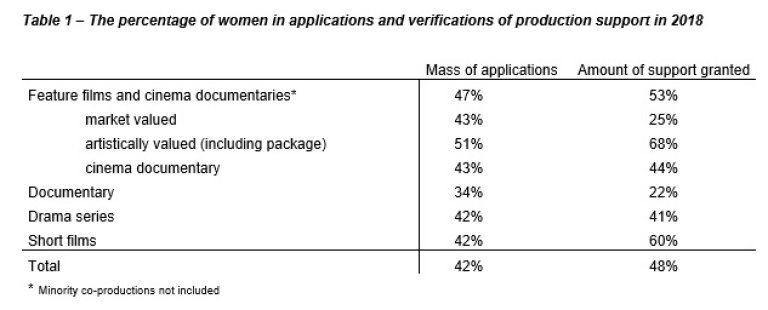
Table 1 shows the percentage of women for all applications and verifications of production support in 2018. The table shows that the percentage of women is higher in the amount of support grants than in the mass of applications in total, but not for all formats. Market valued films (43 per cent of applications and 25 per cent of support grants), documentaries (34 per cent of applications and 22 per cent of support grants), and to a certain degree drama series (42 per cent of applications and 41 per cent of support grants), have a lower percentage of women than the mass of applications. The lowest percentage of women is observed among documentaries (22 per cent of support grants), and the highest among artistically valued films (68 per cent). In total, the percentage of women for the amount of support grants for production is 48 per cent. The results in able 1 are compared over time in Table 2.

The results in Table 2 show a positive development for all formats in 2018, with the exception of documentaries. The percentage of women in feature films and cinema documentaries is the highest since registration began, for short films it is the second highest since the record year 2014 (with a decrease of 1 percentage point). At the same time it should be pointed out that documentaries have the lowest percentage of women since registration began.
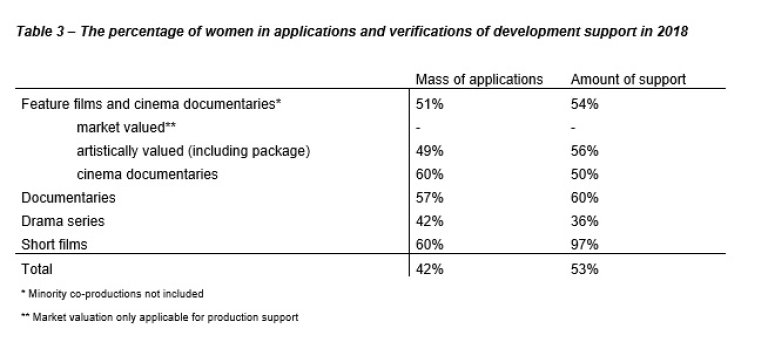
Table 3 shows the percentage of women for applications and verifications of development support in 2018. We see that the percentage of women is five per cent higher in the amount of support grants for development support than for production support in 2018. In contrast to Table 1, we here observe the second highest percentage of women for support grants for documentaries (60 per cent of the amount of support). The highest percentage of women is observed for short films (97 per cent), but it must be emphasized that only five short films were awarded development support in 2018. In total, the percentage of women for the amount of support grants is 53 per cent.
Percentage of women in production support, distributed according to key positions
In this section, we present statistics for the percentage of women in 2017 and 2018, arranged according to the three key positions: Director, Producer, and Screenwriter. The results are displayed in Table 4.
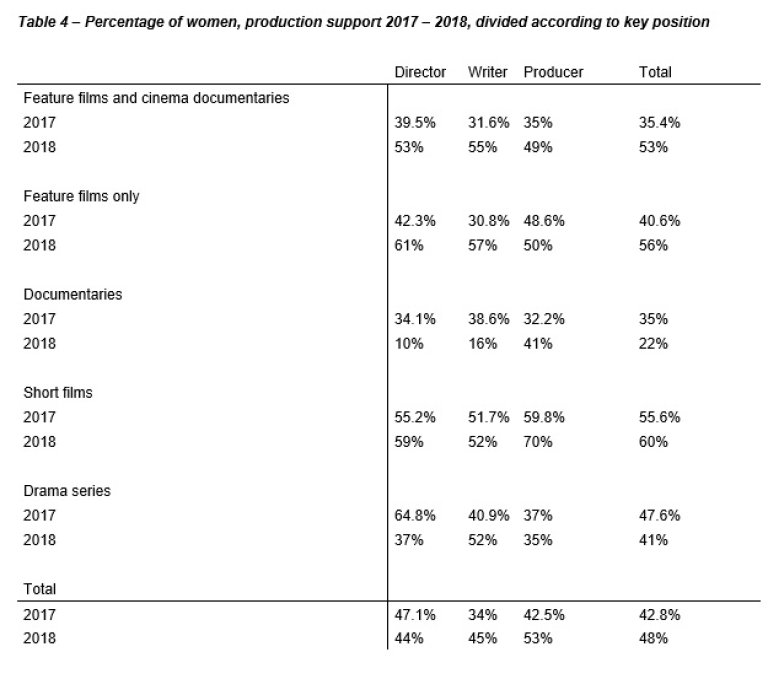
The percentage of women in cinema films is higher for 2018 than for 2017, with an increase from 35.4 to 53 per cent. The distribution for key positions is more than 50 per cent for both directors and screenwriters, while the percentage for producers is 49 per cent. If we disregard cinema documentaries, and focus on feature films only, the percentage increases for all the key positions. This indicates that cinema documentaries have a lower percentage of women than feature films in 2018. Equivalent patterns are found for short films.
Regarding documentaries and drama series, a decrease in the percentage of women is observed. For documentaries, the mentioned decrease is observed for both directors and screenwriters, but for producers there is an increase (from 32.2 per cent in 2017 to 41 per cent in 2018). For documentaries, the decrease is not as strong. For instance, the percentage of women in the screenwriters category increased from 40.9 per cent in 2017 to 52 per cent in 2018, whereas the percentage for producers is almost stable.
Percentage of women, premiere films in 2018
Percentage of women in premiere films – key positions
Table 5 shows the percentage of women arranged according to key positions for cinema films premiering in 2017 and 2018. On the whole, the results show slight variations between the two years. Among films receiving advance support from NFI, there have been few changes from 2017 to 2018, and the percentage of women in key positions shows a minor increase, with 0.76 percentage points. For films without advance support, the development has been more positive, with an increase from 23.6 per cent in 2017 to 31.2 per cent in 2018.
If we disregard cinema documentaries, and focus on feature films only, an increase in the percentage of women from 24.1 per cent in 2017 to 36.9 per cent in 2018 is observed, in total for all key positions. An increase is also observed when cinema documentaries are included in the analysis, but the divergence is not as significant compared to feature films only. The latter observation is due to a higher number of women in key positions in cinema documentaries in 2017 than in 2018.
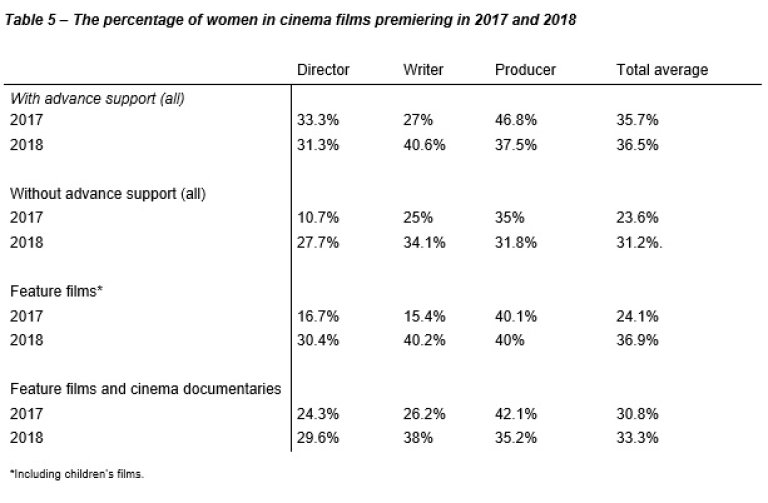
Table 6 provides an overview of the percentage of women in key positions in premiere films between 2011 and 2018.

The percentage of women in premiere films – leading roles
2018 is the third year statistics are kept on the gender balance in leading roles in Norwegian cinema films. The results are shown in Table 7. In 2018, in contrast to previous years, we can observe a percentage of women of more than 50 per cent in Norwegian feature films. The most substantial increase is observed in feature films with advance support, from 25-28 per cent in 2016 and 2017, to 70.8 per cent in 2018. A similar positive development is observed for children’s films as well, with a percentage of women of 50 per cent in 2018. In contrast, the percentage of women is significantly lower for feature films without advance support granted, which has swung back to its 2016 level.
On the whole, the results in Table 7 indicate a deviation from previously reported tendencies, that women are underrepresented on the silver screen.

Descriptive statistics
As previously mentioned, the number of films produced in Norway is relatively low. Table 8 and 9 show the number of production and development applications in 2018, arranged according to type of support and format. Table 10 shows the number of premiere films in Norway in 2018, arranged according to whether they are films with and without advance support from NFI, and to whether they are ordinary feature films, cinema documentaries, or children’s films.
